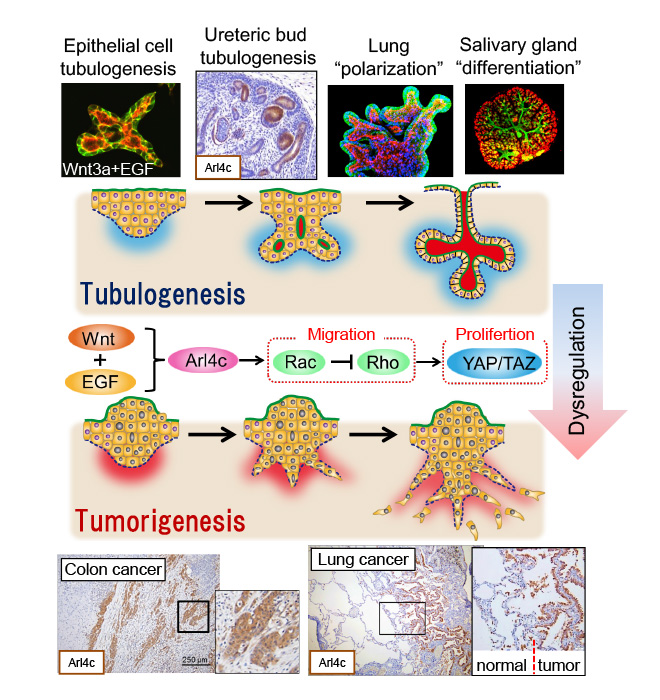|
HOME > Research progress / Achievements > Research progress : Programmed research project 03
 Programmed research project 03Moleuclar mechanism for the formation and maintenance of epithelial tubulogenesis with branching
Research progress
In this research project, based on three dimensional culture and organ culture system, we aim to elucidate the molecular mechanism how epithelial tubules are formed by growth factor signaling and extracellular matrix-mediated cell adhesion in the context of cellular polarization. A novel culture model to recapitulate three dimensional epithelial structure in vitro were generated. When normal intestinal epithelial (IEC6) cells were cultured on basement membrane matrix (Matrigel) three-dimensionally, they formed a spherical structure (cyst), which is characterized by apical-basal polarity with apical surface being oriented towards the lumen and basolateral surface away from the lumen. This apical-basal polarity was induced and maintained by cell-substrate adhesion and Wnt5a signaling that control spatially restricted Rho-Rac activation. Interestingly, in polarized Madin-Darby canine kidney (MDCK) cells, Wnt3a and Wnt5a were secreted basolaterally, whereas Wnt11 was apically, suggesting that polarized secretion of Wnts contributes to the formation of apical-basal polarity. Under three-dimensional conditions, when IEC6 cells were simultaneously stimulated with Wnt3a and EGF (Wnt3a/EGF), they collectively elongated and branched, forming multicellular tubular structures. Wnt3a/EGF induced the expression of Arl4c, which regulates the activities of small G proteins Rac and Rho, resulting in activation of cellular motility through cytoskeletal rearrangement. Morphological changes were observed in leading cells of the tubular structures, where cellular proliferation was promoted by nuclear translocation of YAP/TAZ. In addition, by the use of organ culture system, the expression of Arl4c was found in the distal tip of ureteric bud of mouse embryonic kidney and involved in branching morphogenesis. These results demonstrated the novel mechanism of elongation, branching, and polarization during epithelial tubule formation through the cooperation of growth factor signaling and extracellular matrix-mediated cell adhesion. Furthermore, we found that the ectopically overexpressed Arl4c is involved in tumorigenesis of human cancers with aberrant activation of Wnt and EGF signaling. Arl4c is specifically overexpressed in ~50% of colon cancer and ~70% of lung cancer cases. Downregulation of Arl4c expression significantly suppressed cancer cell migration and invasion and tumorigenesis in vivo. Thus, it is revealed that disruption of regulatory mechanism for epithelial tubulogenesis triggers tumorigenesis of human cancers and Arl4c is possible therapeutic target for cancers. In polarized MDCK cells, we found that Dickkopf1 (Dkk1), a negative regulator for Wnt signaling, is apically secreted, and promotes cellular proliferation. Cytoskeleton-associated protein 4 (CKAP4), a type II tranmembrane receptor, was identified as novel Dkk1 receptor. Both Dkk1 and CKAP4 were overexpressed pancreatic and lung cancers and their simultaneous expression was negatively correlated with prognosis and relapse-free survival. Notably, anti-CKAP4 antibody suppressed xenograft tumor formation of pancreatic and lung cancer in immunodeficient mouse, suggesting that Dkk-1-CKAP4 signaling is also therapeutic target for cancer. In addition, we have generated several organ culture systems such as lung, kidney, and salivary glands. Using lung organ culture system, we found that when combined with FGF10, Wnt/β-catenin signaling continuously induced bud structures from epithelial sheets. We have already identified regulatory factors that are involved in branching morphogenesis downstream of Wnt/β-catenin using DNA microarray analysis and currently examine the impact of them on the branching morphogenesis of fetal lung. In the salivary gland, the regulatory relationship between branching morphogenesis and acinar differentiation was analyzed. Salivary gland epithelium actively branches at their end buds and differentiates into acini, resulting in the acquisition of secretory function. Although branching morphogenesis and functional differentiation cooperatively proceed spatially and temporally, the regulatory mechanism of this cooperation has been unclear. We have found the novel mechanism that several humoral factors can cooperatively regulate morphogenesis and functional differentiation. Taken together, we proposed novel regulatory mechanisms for epithelial polarization and tubulogenesis and revealed the involvement of their dysregulation in cancers.
|








